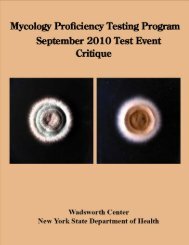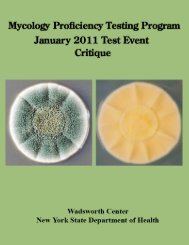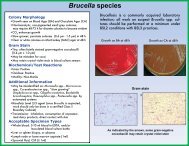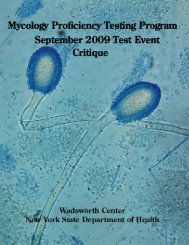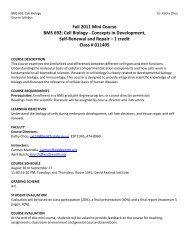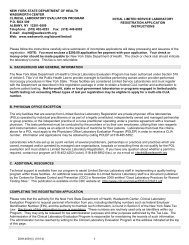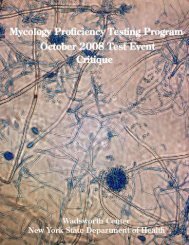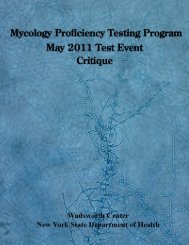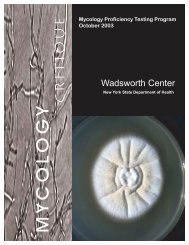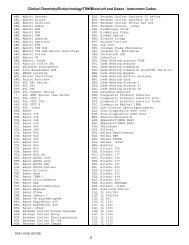September 2007 - Wadsworth Center
September 2007 - Wadsworth Center
September 2007 - Wadsworth Center
Create successful ePaper yourself
Turn your PDF publications into a flip-book with our unique Google optimized e-Paper software.
YEAST DESCRIPTIONSY-1 Candida dubliniensisSource: Blood / Throat / Stool / UrineScoring:No. LaboratoriesReferee Laboratories with correct ID: 9Laboratories with correct ID: 41Laboratories with incorrect ID: 11(Candida albicans) (11)History: Candida dubliniensis is a chlamydospores-positive, germ tube-positive species of Candida, whichis closely related to Candida albicans. It was first described in 1995 by Sullivan et al. from Dublin, Ireland(9).Clinical Significance: Isolates were initially recovered from the oral cavities of HIV infected individualsand AIDS patients causing erythematous and/or pseudomembranous oral candidiasis or angular cheilitis. C.dubliniensis has also been isolated from other body sites including lungs, vagina, blood, and feces.Ecology: C. dubliniensis is globally distributed, but may be restricted to humans as there is only one C.dubliniensis isolation from a nonhuman source - tick samples from an Irish seabird colony (7).Laboratory Diagnosis:1. Culture – On Sabouraud’s dextrose agar after 7 days at 25°C, colony was white to cream, smooth, andsoft (Figure 13). This isolate of C. dubliniensis did not grow at 42°C.2. Microscopic morphology – Lactophenol cotton blue mount showed abundant branched pseudohyphaeand true hyphae with blastoconidia. Many chlamydospores in single, pairs, chains, and clusters wereobserved on Corn meal agar (Figure 14).3. Differentiation from other yeasts – Phenotypically, C. dubliniensis is practically indistinguishable fromC. albicans. One physiologic feature that does appear to be fairly stable is that C. dubliniensis growspoorly or not at all at 42°C while C. albicans grows well at this temperature. In addition, C. dubliniensisis able to assimilate glycerol, but not xylose nor trehalose. However, C. albicans is the opposite. Somecommercial yeast identification kits such as the API 20C AUX, VITEK II, or the ID 32C have the codesfor C. dubliniensis included in the databases. These two closed related yeasts can also be distinguishedby molecular tools.4. In vitro susceptibility testing – Several isolates of C. dubliniensis have been found to have higherresistance to fluconazole than other pathogenic species of Candida, and the resistance to fluconazole maybe induced in some originally sensitive strains. This fact may have serious implications forimmunocompromised individuals on prolonged regimen of fluconazole.5. Molecular tests – Genetically, Candida dubliniensis has been found to be distinct from C. albicans inDNA fingerprinting studies even- though the two species are closely related phylogenetically. Several C.dubliniensis molecular probes are available in reference laboratories.The identity of the test isolate was confirmed in Mycology PTP program by sequencing of its ITS1 andITS2 regions of rDNA. 100% identity was found between this PT specimen and C. dubliniensis M 334a32



